It was a year ago that I wrote: “Be Still and Know.” And I still believe, but now even more so, that stillness is, as Mary Oliver put it, “one of the doors into the temple.” Gosh, I love those words. I’m a Mary Oliver fan from way back.
The longer I bird and the longer I take wildlife photos, the better I understand the importance of being still. I quoted photographer, David Shaw, in the above piece. His words: “The first, and most important, skill for getting close to wild birds is really a non-technique, technique. It’s called ‘patience,'” ring even truer for me today. The idea of “letting birds come to you,” as opposed to stalking them, is advanced by countless birding guide authors and authors of articles about wildlife photography, including Andrew Garn, who touched on the topic in his brief National Audubon Society article, “Pigeons are Beautiful, so Start Photographing Them.”
All Birds Are Birds
I would have added an exclamation point at the end of Andrew’s title. I continue to be a big fan of photographing common birds, including another non-native species brought to our shores (and introduced in Central Park): the European Starling.
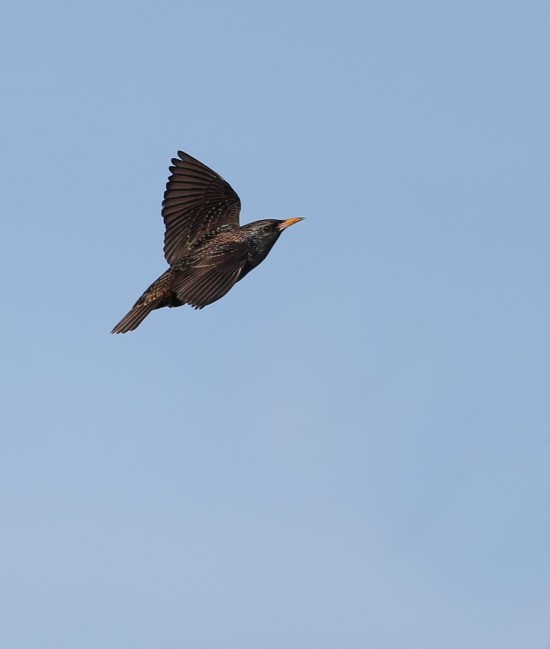
Recall what I wrote at the end of “Bird Photos and Photo Tips at Midyear.” “If nothing much is happening [meaning if nothing else is around], capture starlings and dragonflies.” That statement about creating opportunity might not sound like much of an endorsement, but the truth is, I love training my lens on starlings whenever a flock shows up nearby. For this photographer, anyway, all birds are birds, and all birds are fair game.
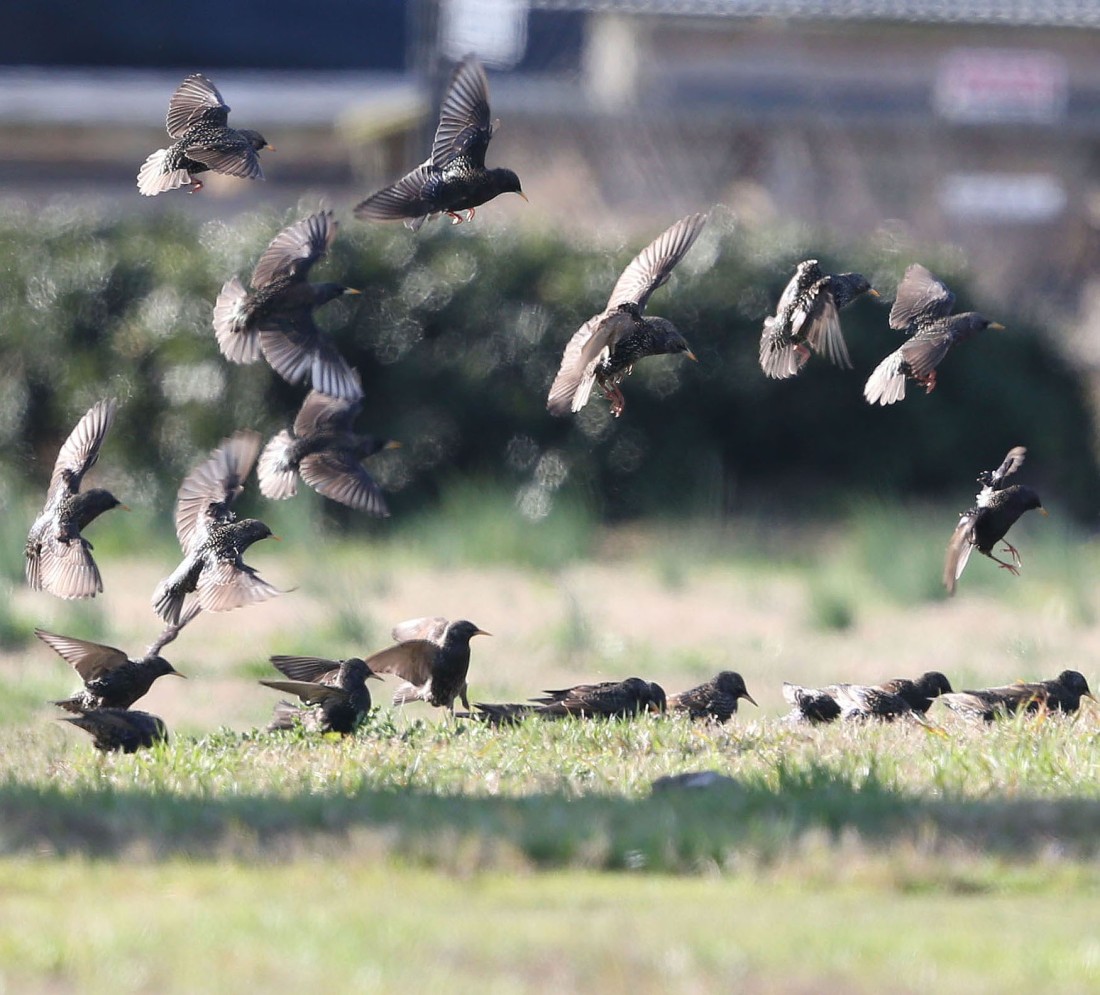
Bird Photo Tip
I usually use some form of Zone AF (a larger group of AF points) when I photograph starlings in flight. I seldom use a single point or AF point expansion—though both will work—and I never target just one bird. I let my camera’s autofocus system choose which bird(s) to focus on and hope for the best. I spray and pray (or grip and rip). I didn’t target the lone bird above. My camera chose it, and I cropped it from a larger image. Shooting flocks this way can be a great way to capture and freeze single birds or small clusters.
A Conversation About Juncos
What I said about all birds being fair game reminds me of a conversation I had on the online photography forum: fredmiranda.com. Tony Markle, aka “Imagemaster,” had posted an eye-catching photo of a Dark-eyed Junco.
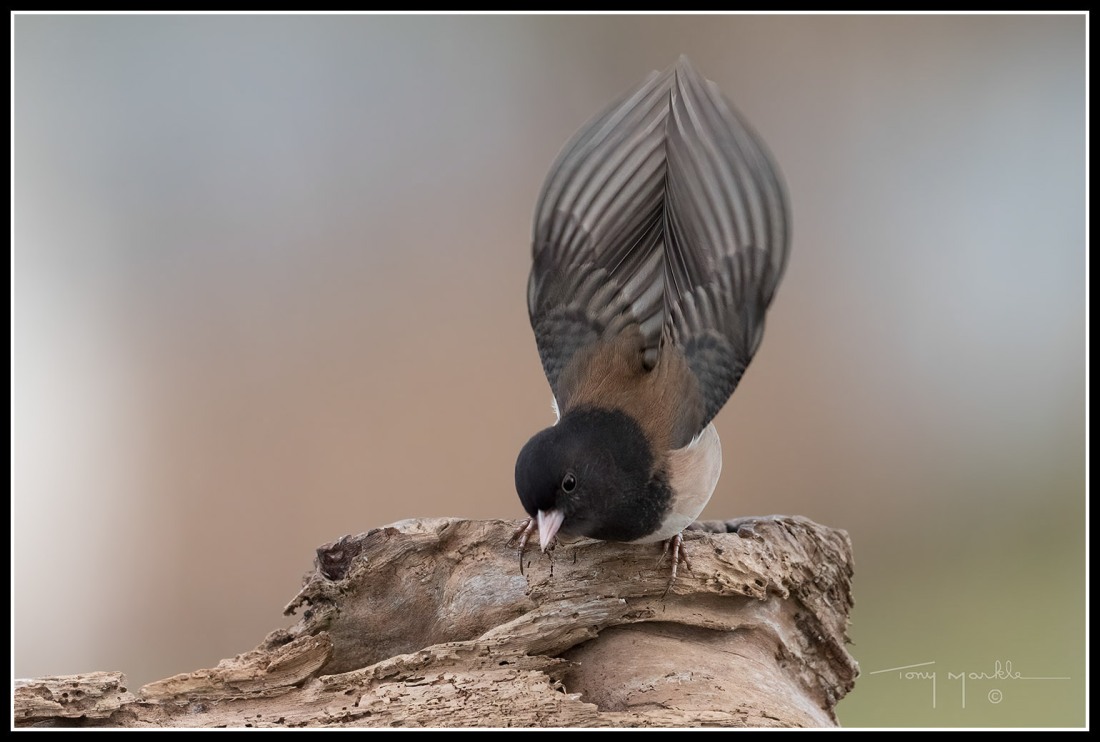
Someone commented: “I glossed over this post numerous times. What would be interesting about a dark-eyed junco? Glad I checked it out. That’s just a fantastic shot!!” I responded: “I love that line: ‘What would be interesting about a dark-eyed junco?’ and laughed out loud when I read it. Funny line, but understandable. One could ask that same question about a whole host of species. What would be interesting about a chickadee, for example? Ask Colin Franks that question (and take a look at his Chestnut-backed Chickadee photo).
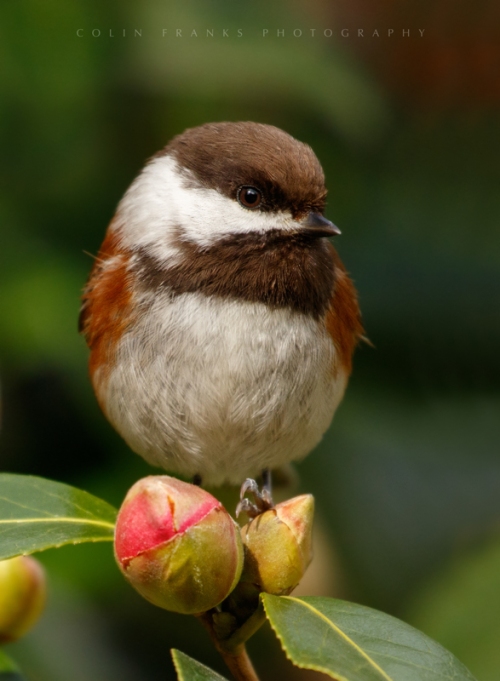
Anyway…great shot, Tony. To all: There’s fascination in every species.”
A Conversation About Geese
I was involved recently in another conversation—this time about Canada Geese—on the “Maryland and DC Birding” Google Group. It began as a response to my last blog, “A Few Words About Birds,” in which I featured a photo of a pair of geese landing in Lakeside Park near our home in Chesapeake, Virginia. Now, here’s a single bird doing just the opposite—taking off from the Elizabeth River.

The conversation started this way: “Resident Canada Geese have become pests in the last 30 years. Degrading wetland habitat and public open spaces like any park with a pond.”
I responded: ” I understand your point, Tom, and appreciate your comment, but I think that geese, sort of like straws, are just a tiny part of the much bigger and very serious “degrading habitat” problem. I also look at geese like I look at crows—as highly visible forms of wildlife that have the potential to awaken in folks, especially urban folks, an interest in birds and in nature and conservation. One more related point…geese and crows because of their visibility and availability are great objects of study, the problems they cause notwithstanding. Just my thoughts.”
Bud Poole chimed in. He wrote: “In my opinion, CANG [Canada Geese] are more a nuisance to invasive habitat such as golf courses, lawns, and parks. These aren’t natural habitats…” He finished his comment with these insightful lines: “I live at Patterson Park in Baltimore, MD and high visibility birds are critical to fostering interest within the inner city. Most county/suburban folks don’t understand this because they are fortunate to have much more at their disposal and possess the means to explore more.” He hit the nail on the head (and also bailed me out). And I’m sure he wasn’t just thinking about Canada Geese there.
Common Birds
I’m making a big deal of common birds. But there’s a reason.

Like a number of you, I’m familiar with the recent study in the journal, Science, about the loss since 1970 of 3 billion birds in the continental U.S. and Canada. The link I provided will take you both to the study and to the Cornell Lab of Ornithology article about the same. One of the key study findings was this: “Common birds—the species that many people see every day—have suffered the greatest losses.”
A few days after I read the Cornell Lab Living Bird article, I ventured into the backyard to try and record a Northern Cardinal. Northern Cardinals, like Tufted Titmice, like Carolina Chickadees and many others, are once again singing their primary songs. I had no luck even locating the cardinal. But I did come across another common bird, a winter-visiting White-throated Sparrow. Little did I know that it had dived for cover when I entered the yard. As I walked by the tall hedge next to our porch, the bird called out. I had my recorder and shotgun mic at the ready, so I recorded its calls.
A few days later, I grabbed my photo gear and headed once again to the backyard to shoot what was in all likelihood a breeding pair of Mourning Doves. Also common birds. It appears the male, the one with the rosier breast and look, is on the left. They were clearly enjoying our newly-installed fence.
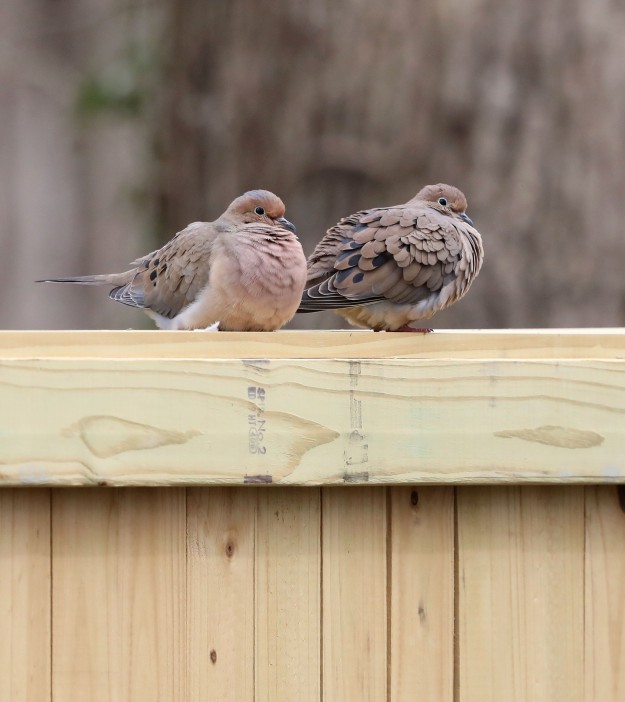
While I was in the yard, a few White-throated Sparrows showed up under the feeders. So, I steadily made my way to a nearby paving stone and sat down to take some photos. I always shoot at eye level when I can—to get a better perspective, a better background, and better subject illumination. Here’s one result.
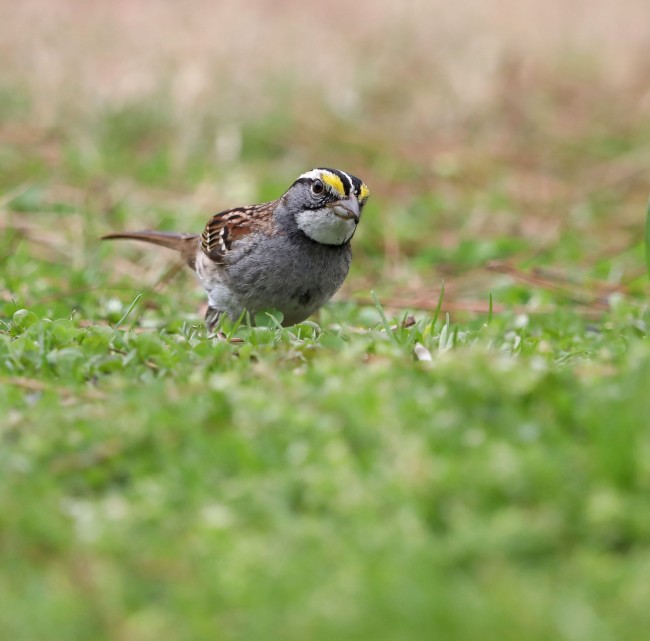
As I was watching the bird while trying to capture it, I thought back to recording the bird in the hedge. Then I thought of the Living Bird article and the research. It was at that point that what I’d read about the disappearance of common birds hit me in a new and personal way. According to the study, 1 in 3 White-throated Sparrows has been lost. The bird I was watching, the bird I’d recorded, the irrepressible singer of “Old Sam Peabody, Peabody, Peabody,” and the bird I’ve known since my youth in Wellesley, was in serious decline. I wrapped up, went inside, and wrote something in my journal about grieving the loss of the familiar.
We birders often attribute human characteristics to birds. And we’re often mistaken. But having said that—isn’t it easy to imagine the White-throated Sparrow pictured above gesturing as a means of expressing a plea for help? I think it is.
“[G]eese and crows because of their visibility and availability are great objects of study, the problems they cause notwithstanding.”–Just want to point out this is a HUMAN–not animal–caused problem. Everyone blames the animals that are just leading their lives.
The reality is that geese did not formerly live in Virginia year-around. They were released (stocked) by your government. So-o-o, I wish folks would stop blaming these animals for increasing in number where there’s good habitat for them. The perpetuation of life is what it’s all about so these species are doing what comes naturally. You can’t blame them for that.
Additionally, their numbers would be brought down naturally if people would accept living with predators–which is the way life needs to be–such as coyotes. People are their own worst enemy because they simply refuse to live in agreement with nature.
Sincerely,
Marlene
LikeLike
All good points, Marlene, and thanks for reading and commenting. I should have put the word “problems” in quotes. Indeed, geese aren’t the problem and more broadly, birds aren’t the probelm. We are.
LikeLike
Wow, there is so much here in this one blog! I will keep coming back for days to ponder and admire! And that Junco shot truly is phenomenal! But the message of being still and patient is so true. When we work with God, and he tempers our character, and we learn to be still, we can hear from Him more and more… even in simple things that many others overlook. Thanks for writing this blog! William — “What a wildly wonderful world, God! You made it all, with Wisdom at Your side, made earth overflow with your wonderful creations.” Psalms 104 The Message
LikeLike
Thank you, William. So glad that you’re a reader.
LikeLiked by 1 person
Dave,
Thank you for expressing what I enjoy most about birding…finding joy and beauty in what is there(common) everyday. Seeing something unusual and rare makes the pulse quicken, but seeing the regulars in my yard is what gives me contentment. Great photos…I love your ground level technique!
Terry Webster
LikeLike
What a great comment, Terry. Thanks so much. Not sure what prompted this (your use of the word “contentment”?), but imagine what a better place this world would be if more and more people took up birding. Yes, nothing like shooting at ground level. It has a way of elevating, and elevating in importance, the target. It also makes for a much more pleasing photo!
LikeLike
Thank you for this excellent article, Dave. I enjoyed every word! Jady Conroy
LikeLike
So glad you did, Jady. I worked hard at it and, of course, received a lot of good help.
LikeLike
Hi Dave – I so enjoyed your premise and totally agree that the “common” birds are just as fascinating as those that we”stalk” for our life list. (Your photographs are truly unique and special!) However, I do take issue with your affinity for the non-native Starling (albeit a beautiful bird) – and I also will include the House Sparrow here in my discussion point. As an avid (native) Eastern Bluebird lover I have personally witnessed both of these non-native species repeatedly kill and/or displace my beloved breeding Bluebirds and other native species such as Tree Swallows and Chickadees. So, to celebrate these destructive species does not service to our beloved native birds.
LikeLike
Tess, thanks, and good points. I was making a case for common birds in general, which would include the European Starling and the House Sparrow. I was also making a case for photographing the same (at least when there’s nothing else around). For the record, I wasn’t celebrating starlings, and like you, know the havoc they cause. All the best, and keep up the important work you’re doing helping Eastern Bluebirds and other natives. Folks like you are making a difference.
LikeLike